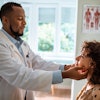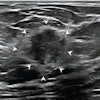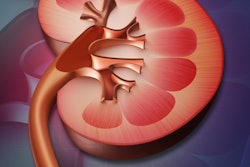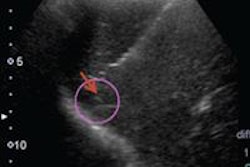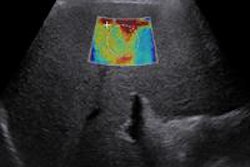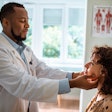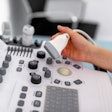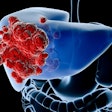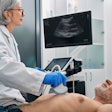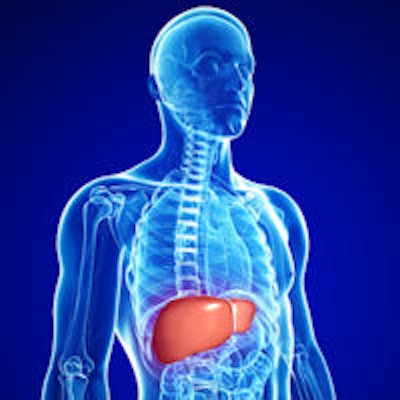
While major adverse events from liver biopsy guided by ultrasound or CT are extremely rare, variables such as the patient's platelet count can increase the risk for hematoma from the procedure by as much as fourfold, according to a large retrospective analysis performed at the Mayo Clinic in Rochester, MN.
In an analysis of more than 6,000 image-guided liver biopsies published online January 30 in Mayo Clinic Proceedings, the researchers found a hematoma incidence of 0.5% and one patient death from image-guided liver biopsy. Factors such as a platelet count of 50,000/µL or less, the performance of more than two biopsy passes, and female gender were associated with a significantly greater risk of postbiopsy hemorrhage.
"Interventionalists can use our data to help them inform their patients about the risks associated with undergoing liver biopsy," lead author Dr. James Boyum told AuntMinnie.com. "With an appropriate platelet level and by minimizing the number of biopsy passes, interventionalists can minimize the risk of a hemorrhagic adverse event."
Relatively safe
Liver biopsy can be an important component in diagnosing the etiology of liver disease, and it has been shown to be relatively safe with a low incidence of major adverse events, said Boyum, who is now at the University of Minnesota.
"Major bleeding is a known complication, but due to its low incidence, there is limited data to indicate which patients are at increased risk," he said.
 Dr. James Boyum from the Mayo Clinic.
Dr. James Boyum from the Mayo Clinic.To delve further into this topic and determine the risk factors for major adverse events, the team respectively analyzed a core biopsy registry internally maintained at the Mayo Clinic for image-guided liver biopsies performed between December 7, 2001, and December 31, 2013. The final analysis included 6,613 image-guided liver biopsies performed on 5,987 adult patients.
The liver biopsies were typically performed under real-time guidance on an Acuson Sequoia (Siemens Healthcare) or a Logiq E9 (GE Healthcare) ultrasound scanner, and with rare exceptions, a Bard Monopty (C.R. Bard) spring-loaded biopsy device was used.
While the specific path to the liver was based on operator preference, the standard technique for both ultrasound-guided biopsy of focal liver lesions and parenchymal liver transplant lesions consisted of two passes with an 18-gauge biopsy needle. Ultrasound-guided native parenchymal liver biopsies used a single pass with a 16-gauge biopsy needle, according to the researchers.
Of the 6,613 biopsies, 250 (3.8%) were conducted under CT guidance and were performed coaxially.
There were 49 (0.7%) acute and delayed major adverse events (hematoma, infection, hemothorax, and death) after the 6,613 ultrasound-guided biopsies were performed, including 34 (0.5%) hematomas that required transfusion and/or angiography. Thirty-one (83%) of the 34 postprocedure hematomas were acute events, occurring within 24 hours after biopsy.
While none of these patients required surgery for bleeding, 76% received a blood transfusion and 59% underwent angiography, Boyum said. Two of the three patients who had a delayed hemorrhage resumed taking anticoagulants.
Three patients (0.05%) died within 30 days of the liver biopsy; one death was directly related to the biopsy. That patient initially had an uneventful course after liver biopsy, which had established the diagnosis of metastatic renal cell carcinoma. She began taking low-molecular-weight heparin 30 hours after biopsy, but later presented with hypotension and a large perihepatic hemorrhage three days postbiopsy. Hemorrhagic shock and multiorgan system failure ensued, and the patient died 10 days later despite having received aggressive treatment, according to the researchers.
As for other major adverse events, eight patients (0.1%) in the study had an infection and four (0.6%) had a hemothorax following image-guided biopsy. There were no cases of pneumothorax.
Risk factors
The researchers then sought to determine any significant risk factors for hematoma, performing statistical analyses on variables such as platelet count and international normalized ratio; patient-related factors such as age and sex; biopsy technique variables such as CT or ultrasound guidance, parenchymal or focal biopsy, needle size, and number of passes; and medication variables including aspirin or clopidogrel.
Statistically significant risk factors for hemorrhage included the following:
- Platelet count of 50,000/µL or less (range, 16,000-49,000/µL) (p = 0.001)
- Female sex (p = 0.007)
- More than two biopsy passes (p = 0.04)
Patients with a platelet count of 50,000/µL or less had a 2.2% risk of hematoma, compared with 0.5% for patients with a platelet count of more than 50,000/µL. While their overall risk remained low (0.8%), women had an approximately threefold increased risk of hematoma compared with men (0.3%). It's unknown why women are at increased risk of hemorrhage, Boyum said.
No other variables were found to provide a statistically significant increased risk for hemorrhage. The researchers were surprised to not find a higher risk for hemorrhage in the 22% of patients who were on aspirin within 10 days of the biopsy, Boyum said.
The researchers acknowledged a number of limitations to their study, including its reliance on direct communication with patients and review of the electronic medical record for recording adverse events in the registry.
"Particularly in patients who leave our institution, such adverse events may not be clearly documented, precluding inclusion in this review," they wrote. "Fortunately, given the low incidence of adverse events, such rare omissions are unlikely to substantially affect the overall results."
The internal registry also includes a large number of patients for whom data were collected over a long period of time by multiple nurses in the radiology department. Although the researchers said they hope the data are accurate, they recognize that, invariably, there may be some errors or omissions. Also, the low incidence of adverse events limits the ability to ascribe significant risks to potential factors such as the use of aspirin or other anticoagulants, according to the group.
Nonetheless, "image-guided liver biopsy performed by subspecialized interventionalists on a large cohort of patients at a tertiary medical center has been shown to be relatively safe, particularly when the platelet count is above 50,000/µL," Boyum said.



